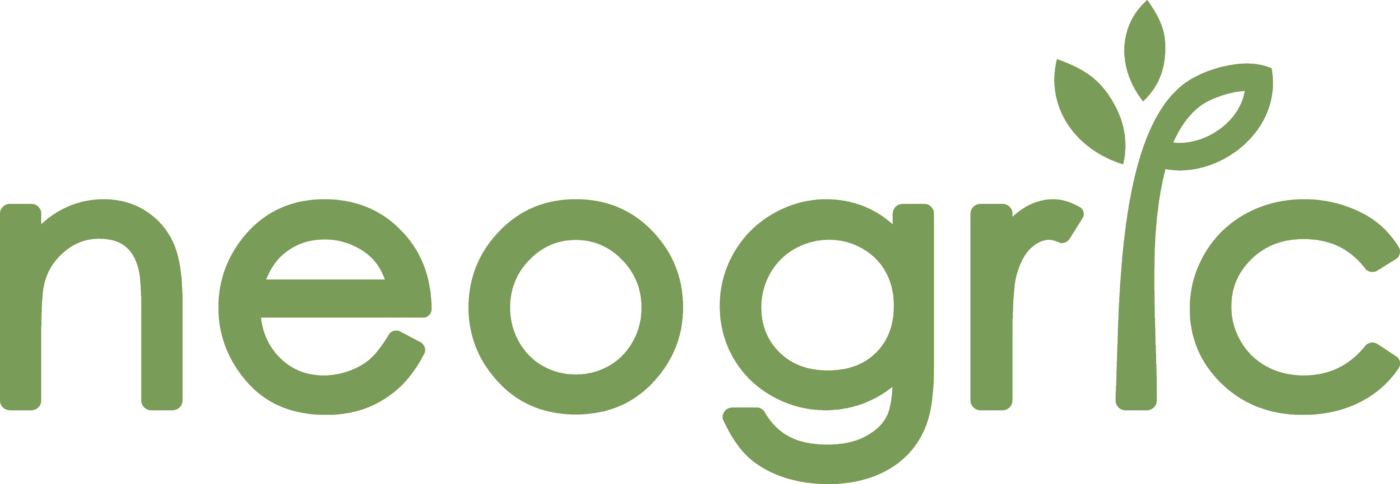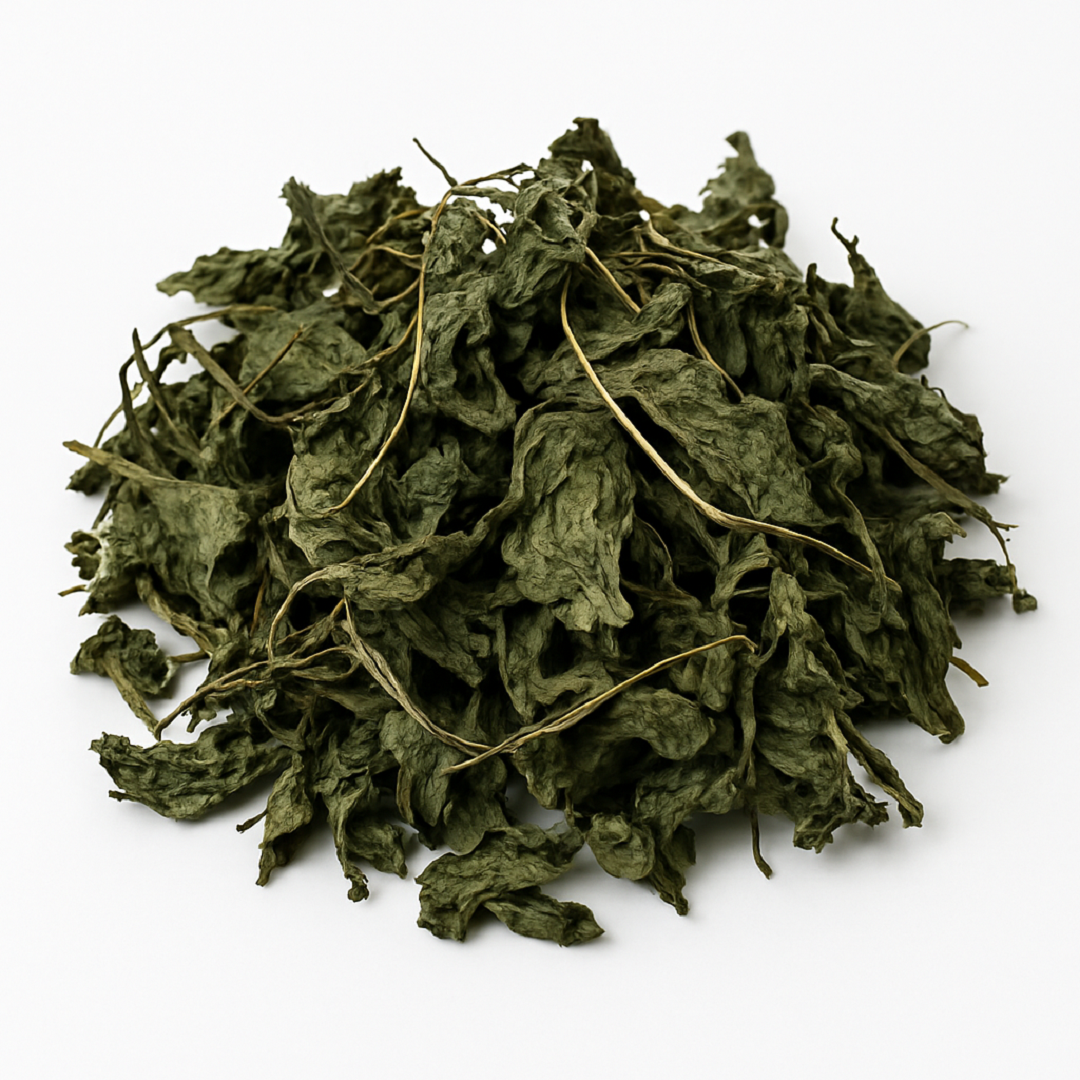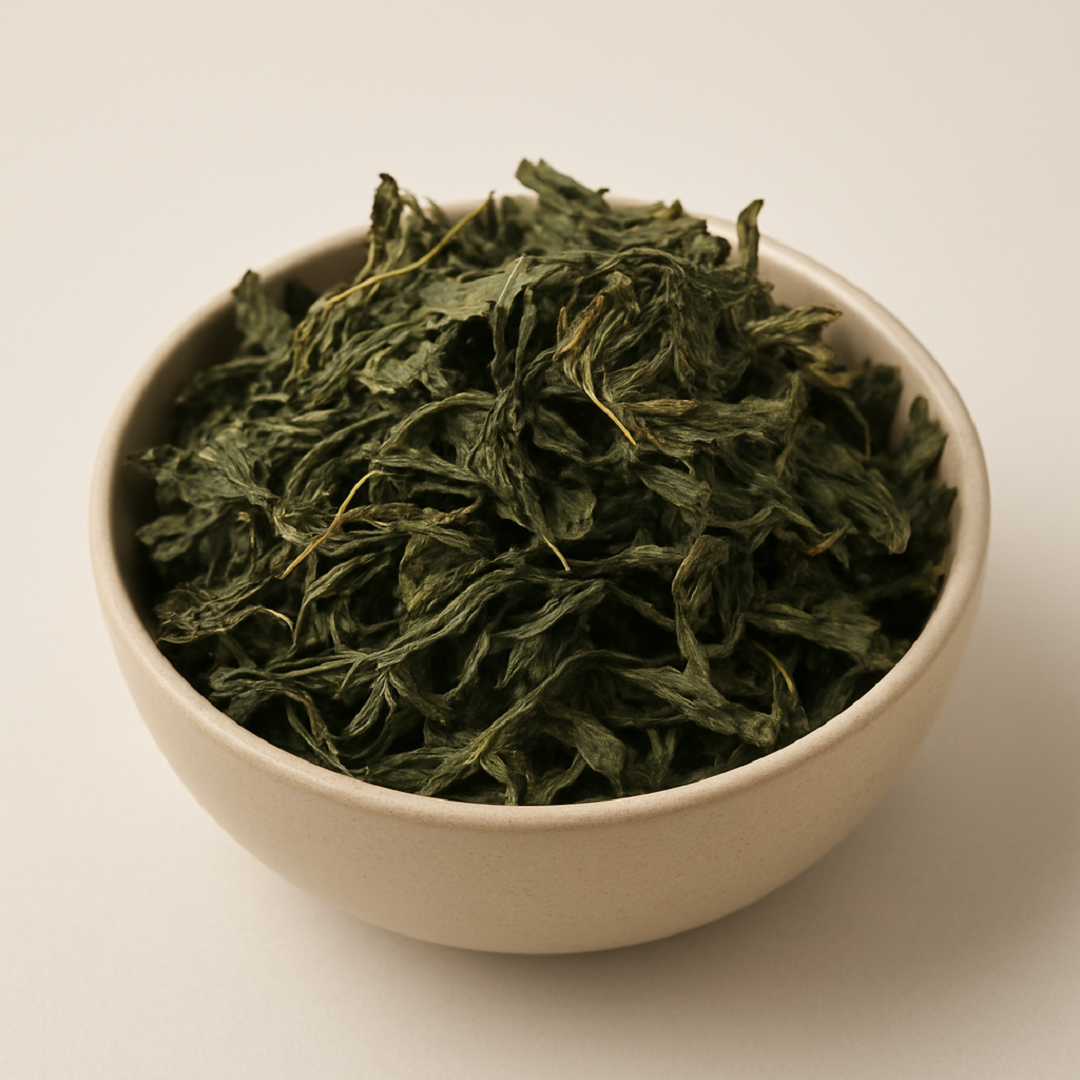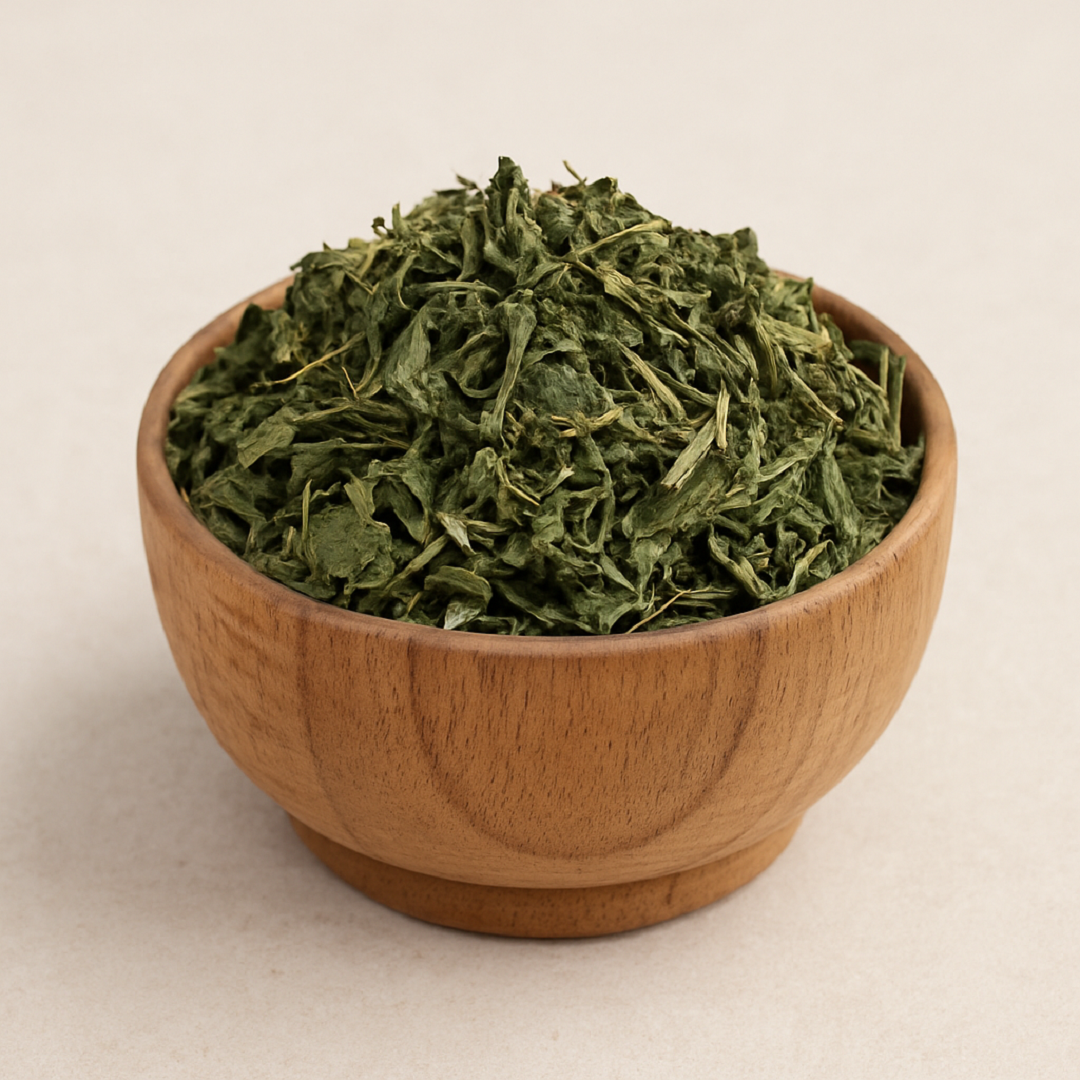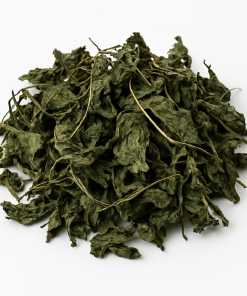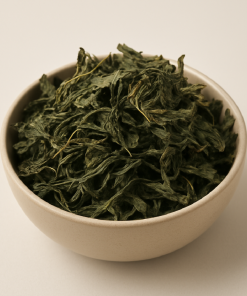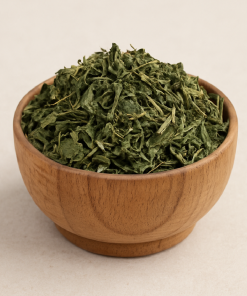What is Dried Waterleaf? Why Buy It?
Dried Waterleaf is the dehydrated form of Talinum triangulare, a leafy green vegetable native to West Africa and widely cultivated in tropical and subtropical regions. Known for its succulent, spinach-like texture and rich nutritional content, waterleaf is traditionally consumed fresh but is increasingly being processed into its dried form to extend shelf life, ease transportation, and increase accessibility in regions where fresh produce is less readily available.
The drying process involves the careful dehydration of waterleaf leaves under controlled conditions to retain their vibrant green color, flavor, and nutritional integrity. Once dried, the product becomes lightweight, compact, and storable for months without refrigeration —making it ideal for export and long-term use in both home and commercial kitchens.
Consumers and businesses buy Dried Waterleaf for several reasons: Dried Waterleaf is a powerhouse of essential nutrients including vitamins A and C, iron, calcium, potassium, and antioxidants. These nutrients are mostly preserved in the drying process, making it a healthy dietary supplement.
Unlike the fresh variety, Dried Waterleaf can be stored for extended periods without refrigeration, making it more convenient for global shipping and storage in regions with limited cold chain infrastructure.
It retains much of the flavor profile of fresh waterleaf and can be rehydrated easily for use in traditional soups, stews, sauces, and herbal preparations. For members of the African diaspora and global food enthusiasts, Dried Waterleaf offers a taste of home or an opportunity to experiment with African culinary traditions.
As demand grows for indigenous African vegetables in global health food markets, Dried Waterleaf is emerging as a premium export commodity with rising market value.
Applications/Uses of Dried Waterleaf
Dried Waterleaf serves diverse purposes across culinary, health, and agricultural domains. Its versatility makes it a sought-after ingredient for both traditional uses and modern innovations.
Culinary Applications
Traditional Cuisine
In West African countries like Nigeria and Ghana, Dried Waterleaf is a core ingredient in traditional dishes such as:
Edikang Ikong Soup
A rich vegetable soup made with a mix of waterleaf and fluted pumpkin leaves (ugu).
Afang Soup
A famous Cross River and Akwa Ibom dish where Dried Waterleaf is blended with okazi leaves for a hearty stew.
Efo Riro
A Yoruba vegetable sauce where Dried Waterleaf can serve as a substitute or addition to spinach or fluted pumpkin.
Global Fusion Cuisine
As African ingredients gain popularity in fusion cuisine, chefs and food manufacturers are incorporating Dried Waterleaf into Vegan stews, Herbal broths, Stuffings, Smoothie powders and green supplements
Convenience Foods
Because of its concentrated flavor and long shelf life, Dried Waterleaf is also used in Instant soup mixes, dehydrated meal kits, Foodservice seasonings
Nutraceutical and Medicinal Uses
Traditional Herbal Medicine
Waterleaf has long been used in African traditional medicine. When dried, it retains many of its medicinal properties and is used in:
Detoxification teas
For cleansing the digestive system.
Blood sugar regulation
Known for its hypoglycemic effect.
Blood pressure management
Its high potassium and magnesium content contribute to cardiovascular health.
Dietary Supplements
Ground Dried Waterleaf is being incorporated into capsules and powders for the wellness market, offering natural options for immune support, digestion, and vitality.
Agricultural and Environmental Applications
Animal Feed
The dried leaves can be used as a supplement in animal feed, especially in poultry and livestock farming, due to their high protein and fiber content.
Organic Fertilizer and Mulch
When composted, Dried Waterleaf contributes to soil health due to its rich organic matter content, making it a sustainable option for natural farming.
Top Producing/Exporting Countries of Dried Waterleaf
Production of Dried Waterleaf is concentrated in regions where the fresh variety is traditionally cultivated, and where drying infrastructure supports post-harvest processing. The leading countries are primarily in West Africa, with emerging interest from the Caribbean and parts of Asia.
Nigeria
Nigeria is the leading producer and exporter of Dried Waterleaf globally. States such as Cross River, Akwa Ibom, Rivers, and Delta are major cultivation hubs. The country has a strong domestic consumption culture and a growing export network serving African diaspora communities in the United States, Canada, the UK, and other parts of Europe.
Ghana
Ghana is another major producer with significant waterleaf farming in its southern regions. Ghanaian entrepreneurs are increasingly tapping into the dried vegetable market by exporting to Europe and North America.
Cameroon
In Cameroon, waterleaf farming is widespread, and small-scale processing units are turning the fresh vegetable into dried forms for export to France, Switzerland, and other French-speaking nations.
Benin and Togo
Though smaller in scale, these countries are known for exporting niche varieties of Dried Waterleaf, particularly to France and the UK. Exporters often work with cooperatives and women’s farming groups.
India and the Philippines (Emerging Producers)
While not traditional waterleaf growers, some experimental cultivation is taking place in India and Southeast Asia for local use and niche export, owing to growing demand among African and Caribbean expatriates.
Top Importing Countries of Dried Waterleaf
Demand for Dried Waterleaf is growing rapidly in both developed and developing countries, particularly where African communities are present or where there’s a surge in demand for exotic health foods and herbs.
United States
The U.S. is the largest importer of Dried Waterleaf. It is stocked in African and Caribbean grocery stores, health food outlets, and increasingly in online retail platforms.
United Kingdom
With a large Nigerian and Ghanaian population, the UK sees a steady demand for Dried Waterleaf. It is available in both traditional markets and supermarket chains stocking African and Caribbean foods.
Canada
Canada has seen increasing demand due to its multicultural population. Dried Waterleaf is imported by specialty retailers and e-commerce businesses catering to immigrants and foodies.
Germany and the Netherlands
These European countries import Dried Waterleaf for their growing African and Asian immigrant populations. Germany, in particular, has a thriving herbal medicine industry where waterleaf is entering as a supplement ingredient.
United Arab Emirates
The UAE, especially cities like Dubai and Abu Dhabi, imports Dried Waterleaf for its substantial West African expatriate population and as part of the ethnic food offerings in global supermarkets.
France and Belgium
Due to historical ties with Cameroon and other West African nations, France and Belgium are significant importers. The product is popular in African restaurants and open-air markets.
International Price of Dried Waterleaf Per KG
The unit price ($ per KG) of Dried Waterleaf in the international market depends on a host of different factors including:
- The grade of the produce (usually the more the processing, the higher the price)
- The price of the raw material
- Age of the seeds (this can affect the price)
- Production levels in producing countries
- Economic conditions and the exchange rates between the currencies of the producing and importing countries.
- The quantity ordered (the greater the quantity, the cheaper you can get it per ton)
- Harvest season (it is more costly when it is out of harvest season).
- Weather conditions (some commodities are sensitive to weather conditions).
- Freight & haulage cost
- Percentage of markup
- Import duties, trade tariffs and trade agreements between countries
- Distance from the country of origin
- Technology/Infrastructure available in country of origin
- Relationship between the buyer and seller
That said, as at March 2025, Dried Waterleaf costs between $6 and $20 Per KG in the international market.
How To Safely Source for Your Dried Waterleaf Produce
If you find the right export company, buying directly from them can make the purchase process easy and stress-free, when compared with doing the sourcing on your own. That said, there are few things to note when dealing with an export company in Nigeria or Africa. The specific requirements for Nigeria are listed below, but they mostly apply to other African countries:
- The exporting company must be registered with the Corporate Affairs Commission (CAC) to make sure the company is registered and permitted to carry out business
- The export company must also be registered with the Nigerian Export Promotion Council (NEPC).
- The company must possess a domiciliary account to accept international
The company should get all necessary export-related documentation done before the shipment leaves the port of origin. Some of the documents are:
- Certificate of origin
- Bill of lading
- Inspection Certificate (SGS, Cotecna, Bureau Veritas, Intertek, etc)
- Phytosanitary certificate
- Fumigation certificate
Where To Find Reliable Exporters
An important question that still needs to be answered is how to find Dried Waterleaf exporters in Nigeria. You can use any of the methods listed below:
- Attend trade fairs
- Use search engines like Google, Yahoo,
- Search for agents on Linkedln
- Sign up on trade platforms (e.g. Alibaba, Tradeford, Go4WorldBusiness)
- Neogric – Neogric is one of the reliable Dried Waterleaf exporters in Neogric is rated among the best in the exporting business in Nigeria. The company is not limited to the exportation of Dried Waterleaf alone but can export other agricultural produce ranging from perishables to dry seeds.
How To Pay For Your Dried Waterleaf Produce
You can pay for Dried Waterleaf using different methods, but three of the popular ways of paying for your agric produce are:
- Bank (T/T) Payment
- Advance Payment
- Letter of Credit (LC)
Bank Payment (T/T)
Bank payment is also known as T/T, “Telegraphic Transfer” or “Telex Transfer” In other words, it is an international wire of funds from the buyer’s bank to the seller’s bank.
A T/T is technically not the same as a wire transfer, which is often done through the SWIFT network. However, when a seller or supplier asks for a T/T payment, a wire transfer is what they are really asking for.
The wire transfer based on the SWIFT system is the most common payment method in international trade. Typically, it takes 1-5 working days to clear, and generally costs between 25 and 50 USD, depending on your agreement with the commercial department in your bank.
Advance Payment
There are sellers that will demand anywhere from 30% to 50% advance payment, and for good reason. If both parties have done deals in the past, sellers can ask for a percentage of the sales (about 30%) before they ship the produce and they can request for the remaining amount after a scanned copy of the Bill of Lading has been sent to the buyer.
It is the safest option for exporters and it also guarantees that they will have some funds to help with sourcing. It is popular among manufacturers on B2B marketplaces like Alibaba and also with commodity traders.
However, advance payment carries considerable risk for the importer (buyer) because the exporter (seller) might not be under as much pressure to ensure quality checks compared with a stricter form of payment. Some might even disappear entirely.
Having said that, advance payment is very useful and is widely used. For instance, the seller might need to secure the commodity in the face of increased competition. It can also be used when the exporter needs some money for sourcing the produce or for processing raw materials.
The most important thing is for both importer and exporter to build mutual trust by having a track record of successful deals with each other or other known companies.
Letter of Credit
Letter of Credit is an agreement generated by the bank of the buyer, guaranteeing payment once certain conditions are met. It is one of the safest types of payment available to both buyer and seller.
Some of the types of Letter of credit are:
- Commercial Letter of Credit,
- Sight Letter of Credit
- Transferrable or Non-Transferable Letter of Credit
- Standby Letter of Credit (SBLC)
- Usance or Deferred Payment Letter of Credit
- Revocable or Irrevocable Letter of Credit
- Confirmed or Unconfirmed Letter of Credit
- Revolving Letter of Credit
- Green Clause Letter of Credit
- Red Clause Letter of Credit
L/Cs are not totally safe (for either buyer or seller) too. For instance, sellers can ship substandard products or those that are different from the ones agreed upon. In this case, the seller gets paid and the buyer receives goods he cannot use.
And speaking of the dangers of L/Cs for the exporter, the conditions in the Letter of credit might be practically impossible to fulfil; if an exporter agrees to such, he might be unable to receive payment. A report stated that of the letters of credit received in the UK, 50% are unworkable while 70% are rejected by the banks for payment.
Shipping & Delivery Terms
When shipping your products, it is important to take note of a few factors:
Order Quantity
For smaller shipments, airfreight is often the preferred option but as the order volume increases, sea freight could become significantly cheaper. Usually when the order is close to a full container load (20 ft), sea freight is used. Although the Covid-19 pandemic caused an increase in cost of delivery of products, prices have stabilised.
Cost of Delivery
When the order is of a large volume, sea freight often turns out cheaper than air freight. In fact, air freight could be up to 6 times more costly than sea freight if the volume is large enough.
Time of Delivery
Sometimes, time will be more important to the buyer than the cost of delivering the product. In this case, air freight will be the logical option (as stated above, the cost will be more). But if you have more time as a buyer, you should strongly consider using sea freight.
Incoterms
Incoterms refer to generally accepted shipping and payments terms. For example, buyers that have representatives in the source country or that can negotiate with the freight company can use the Free of Board (FOB) terms, since it gives them more control and can save them some money.
However, if the shipment is small or the buyer doesn’t have an extensive network to effectively handle payment for freight, insurance and port charges, he will be better off choosing the Cost-Insurance-Freight (CIF) payment option.
Neogric: Top Exporters and Suppliers of Dried Waterleaf
We invite you to place your order for high-quality Dried Waterleaf with us at Neogric. We are a trusted global commodity sourcing and trade solution provider with deep expertise in the Dried Waterleaf industry. Whether you’re a small business or a large corporation, our wide range of products and technology powered, end-to-end supply chain make the export of quality Dried Waterleaf easy, quick and safe. Whichever region of the world you are, be it Europe, Asia, USA, Canada, Other North/Central American countries, Africa, South America or Oceania, you can reliably order your agricultural produce and we will ensure it is successfully delivered to you, on time.
Why Buy Dried Waterleaf From Neogric?
Choosing Neogric as your Dried Waterleaf supplier offers several advantages:
- Quality Assurance: We maintain strict quality control standards, ensuring our Dried Waterleaf and other products are of the highest quality.
- Wide Product Range: We offer a diverse selection of products, catering to various
- Reliable Supply Chain: Our efficient technology-powered end-to-end supply chain ensures timely delivery of your orders.
- Expertise and Support: Our team of experts provides valuable insights and support, making your purchasing process smooth and hassle-free.
Our Dried Waterleaf Trade Specifications
- Origin: Nigeria
- Product Name: Dried Waterleaf
- Physical Specification: Based On Buyer’s Specification
- Quantity: Based On Buyer’s Specification
- MOQ: 10 Metric Tonnes
- Trade Process: Ex Works/FOB/CIF
- Admixture/Impurities: Based On Buyer’s Specification
- Inspection: SGS/Cotecna/Intertek/Bureau Veritas
- Packaging: Based On Buyer’s Specification
- Payment Method: TT (Bank Transfer) or L/C
- Shipping Time: 15 to 25 Days After Confirmation of TT or L/C
- Loading Port: Lagos (Nigeria), Abidjan (Cote D’ivoire) or Tema (Ghana)
Expected Shipping Documents
- Bill of Lading
- Certificate of Origin
- SGS Inspection Certificate
- Phytosanitary Certificate
- Fumigation Certificate
- Commercial Invoice
- Packing List
Place Your Dried Waterleaf Order With Neogric
Contact us today to place your order for high-quality Dried Waterleaf. Our team is ready to assist you with all your procurement needs.
- Tel: +2348147860157
- Email: neo@neogric.com
- WhatsApp: Chat With Us
